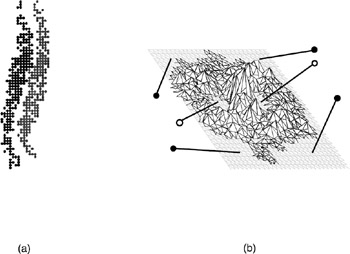3.12 Discussion
|
3.12 Discussion
We have not aimed to provide an overly general explanation nor to offer a complete theory of reaction-diffusion and excitable computing. Rather, we have tried to inspire the reader to move toward still-virgin sites of the field of nonlinear media-based unconventional computing. Thus we have studied several cases of reaction-diffusion processors from computational geometry to robotics to universal machines. Because a more detailed treatment of computing in nonlinear media is already offered (Adamatzky 2001; Rambidi et al. 2002; Adamatzky 2002), in this chapter we simply presented an outline and discussed some recent discoveries in the field.
All considered algorithms of reaction-diffusion computing were tested in cellularautomata models. In automata models, we demonstrated that a dynamic of reaction and diffusion can be successfully employed in the designing of massively parallel processors for image computational geometry and optimization. Analysis of spacetime dynamics of cellular automata models helped us draw a picture of intuitive design of real-life processors. Several real-life processors were fabricated thereby.
In conclusion, we would like to mention two very prospective fields where the reaction-diffusion paradigm can be efficiently applied: evolvable hardware (Miller et al. 2000; Miller and Hartmann 2001) and collective behavior and consciousness.
Considering the pros and contras of field-programmable gate arrays, Miller stresses that hence designed for conventional electronics, the programmable gate arrays are not "rigid" structures and therefore allow the exploitation of physicsand chemistry-based computing (Miller 2000). He thus invites us to take advantage of possibly coupling "conventional" silicon gate arrays with molecular and chemical nonlinear media, and to fabricate field-programmable matter arrays. One of the possible designs of the field-programmable matter arrays is shown in figure 3.10. A configuration of this new smart material is thought to be achievable via variations of voltages on the array's input wires. The idea fits well into a "programmable matter" concept (Toffoli and Margolus 1991) and it already has been supported by some experiments on field-based control of excitation dynamics in a Belousov-Zhabotinsky medium (Marek and Ševč kov 1984; Ševč kov and Marek 1986).

Figure 3.10: Julian Miller's field programmable matter array. (After Miller 2000.)
Can we apply a reaction-diffusion paradigm to study collective behavior of intelligent entities or even to give yet another nonstandard interpretation of cognitive and affective processes in a human mind? What if molecules behave like humans? What if humans act like molecules? Chemical media are not the only ones described by reaction-diffusion equations. It is not uncommon that aggregates of higher complexity, even crowds of people (particularly in extreme situations of panic or excitement), act analogously to laws of physics and chemistry. What if we think on crowds as solutions of reagents? Moods would possibly diffuse but will they interact? What patterns of precipitates or dissipative structures would they form? For example, when fronts of combatants collide and engage in severe fighting, they may leave (possibly just in a naive computational model) corpses behind (figure 3.11a). Could we construct a Voronoi diagram with the help of fighting crowds? This is a possibility.

Figure 3.11: Computation with spreading and reacting crowds. (a) Collision of two fronts of virtual combatants. Simulated in ISAAC software (Ilachinski 1997). (b) Pebble-built Voronoi diagram of five lattice nodes, constructed in a lattice swarm model; data nodes are marked by pins; closed Voronoi cells are indicated by pins with hollow heads. (Modified after Adamatzky 2001.)
Let us consider ant-inspired mobile finite automata, inhabiting a two-dimensional lattice. Each automaton can move, pick up, and drop pebbles. Ideally, we wish to identify those nodes of the lattice that are the edges of the Voronoi cells of the labeled nodes, or data points. Every automaton is given a color corresponding to one of the labeled nodes. Automata start their walks at the nodes of the given set, which is a seed for the lattice subdivision. Automata carry pebbles. When automata of different colors meet at a node, they become agitated and therefore drop their pebbles.
When this process has run its course, the number of pebbles of each color at each node of the lattice indicates the membership degree of this node in the set of edge nodes of the Voronoi diagram (figure 3.11b).
What if we use doxastic or affective components instead of chemicals? Are there any particulars in development of cognitive or emotional reactors? We can easily extract ten abstract reagents that constitute the "material" base of a chemistry of the mind. They are knowledge, ignorance, delusion, doubt, and disbelief, (all of which are derivatives of belief); and happiness, sadness, anger, confusion, and anxiety, (which are primitive types of emotions). Analyzing binary interactions of doxastic and affective reagents, one can derive several realistic scenarios of reaction development in "conscientiousness solutions" (Adamatzky 2001a, 2001b). Some sets of reactions exhibit quite dull behavior, others are more interesting. Thus, for example, the following set of reactions show rich oscillating behavior in an affective liquidreaction filled with emotions:
-
ANGER + HAPPINESS → CONFUSION + HAPPINESS + ANGER
-
ANGER + CONFUSION → CONFUSION
-
HAPPINESS + CONFUSION → ANGER + HAPPINESS.
In this context, two types of reactor vessels are worth investigating: stirred reactors and thin-layer, or nonstirred, reactors. Depending on the particular architecture of the parachemical reactions and relations between doxastic and affective components, the system's behavior exhibits spreading of phase and diffusive waves, formation of domain walls, pseudochaotic behavior, and generation of ordered patterns. A simple case of one-dimensional reaction and diffusion of doxastic (i.e., derived from belief) components is shown in figure 3.12.

Figure 3.12: Diffusion of a doubt d in a one-dimensional layer of knowledge (shown by dots). The doubt reacts with the knowledge and a misbelief (μ) is produced. Ignorance (ι) and delusion (ε) emerge as byproducts of the diffusion and reaction. Certain norms are applied, see Adamatzky, 2001a for details.
|